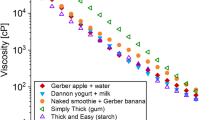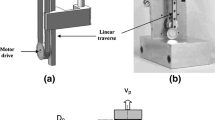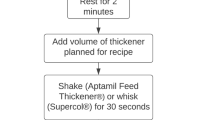Abstract
Thickened infant formula (TIF) prepared with commercial xanthan gum (XG)-based food thickeners are commonly used to care for infants with swallowing difficulties or regurgitation. In this study, the rheological properties of TIF prepared with four commercial food thickeners (coded A–D) were determined as a function of thickener concentration, thickener type, and setting time because the selection of an appropriate food thickener for TIF preparation is necessary for managing dysphagia in infants. The flow and dynamic rheological properties of TIF were investigated at three different concentrations (1.0, 2.0, and 3.0% w/w) of XG-based thickener. The flow properties of TIF were described by the power law and Casson models. All TIF samples demonstrated high shear-thinning (n = 0.12–0.33) behavior at all concentrations (1.0–3.0%). Their apparent viscosity (η a,50), consistency index (K), yield stress (σ oc), storage modulus (G′), and loss modulus (G″) increased with an increase in thickener concentration. In general, TIF with thickener A had much higher values for all flow parameters at each thickener concentration when compared to TIF with other thickeners (B, C, and D). However, the n values of TIF samples with thickener A were much lower, indicating that they are less slimy and have better mouthfeel than those of TIF samples with other thickeners. All TIF samples with different thickeners produced different thickening patterns over a setting time. The flow and dynamic rheological parameters demonstrated differences in the rheological behaviors between XG-based thickeners, indicating that their rheological properties are related to the concentration and type of thickener as well as the setting time. These results suggest the importance of considering not only the concentration and type of thickeners but also the time being administered after its addition to effectively treat dysphagic infants. In addition, selecting an appropriate commercial food thickener appears to be of great importance for the safe and easy swallowing of dysphagic infants.





Similar content being viewed by others
References
Kim SG, Yoo B. Viscosity of dysphagia-oriented cold-thickened beverages: effect of setting time at refrigeration temperature. Int J Lang Commun Disord. 2015;50:397–402.
Smith CH, Jebson EM, Hanson B. Thickened fluids: investigation of users’ experiences and perceptions. Clin Nutr. 2014;33:171–4.
Dodrill P. Disorders affecting feeding and swallowing in infants and children. In: Groher ME, Crary MA, editors. Dysphagia: clinical management in adults and children. St. Louis: Elsevier Inc.; 2016. p. 271–304.
Saigal S, Doyle LW. Preterm birth 3—an overview of mortality and sequelae of preterm birth from infancy to adulthood. Lancet. 2008;371:261–9.
Dodrill P. Treatment of feeding and swallowing difficulties in infants and children. In: Groher ME, Crary MA, editors. Dysphagia: clinical management in adults and children. St. Louis: Elsevier Inc.; 2016. p. 325–50.
Woods CW, Oliver T, Lewis K, Yang Q. Development of necrotizing enterocolitis in premature infants receiving thickened feeds using SimplyThick®. J Perinatol. 2012;32:150–2.
Lee HY, Yoon SR, Yoo W, Yoo B. Effect of salivary reaction time on flow properties of commercial food thickeners used for dysphagic patients. Clin Nutr Res. 2016;5:55–9.
Hanson B, O’Leary MT, Smith CH. The effect of saliva on the viscosity of thickened drinks. Dysphagia. 2012;27:10–9.
Cho HM, Yoo B. Rheological characteristics of cold thickened beverages containing xanthan gum-based food thickeners used for dysphagia diets. J Acad Nutr Diet. 2015;115:106–11.
Cho HM, Yoo W, Yoo B. Steady and dynamic rheological properties of thickened beverages used for dysphagia diets. Food Sci Biotechnol. 2012;21:1775–9.
Seo CW, Yoo B. Steady and dynamic shear rheological properties of gum-based food thickeners used for diet modification of patients with dysphagia: effect of concentration. Dysphagia. 2013;28:205–11.
September C, Nicholson TM, Cichero JAY. Implications of changing the amount of thickener in thickened infant formula for infants with dysphagia. Dysphagia. 2014;29:432–7.
Hong SR, Sun DS, Yoo W, Yoo B. Flow behaviors of commercial food thickeners used for the management of dysphagia: effect of temperature. Int J Food Eng. 2012;8:8.
Szczesniak AS, Farkas E. Objective characterization of the mouth feel of gum solutions. J Food Sci. 1963;27:381–5.
Funami T. Next target for food hydrocolloid studies: texture design of foods using hydrocolloid technology. Food Hydrocoll. 2011;25:1904–14.
Payne C, Methven L, Fairfield C, Bell A. Consistently inconsistent: commercially available starch-based dysphagia products. Dysphagia. 2011;26:27–33.
Sworn G. Xanthan gum. In: Imeson A, editor. Food stabilisers, thickeners and gelling agents. Oxford: Blackwell Publishing Ltd.; 2010. p. 325–42.
Acknowledgements
This work (2016R1A2B4010803) was supported by Mid-career Researcher Program through NRF grant funded by the MEST. This work was partially supported by the research program of Dongguk University, 2016. We would like to thank Rheosfood Inc. for providing technical assistance and the free food thickener A (Visco-up) sample.
Author information
Authors and Affiliations
Corresponding author
Ethics declarations
Conflict of interest
The authors have no conflicts of interest to declare.
Rights and permissions
About this article
Cite this article
Yoon, SN., Yoo, B. Rheological Behaviors of Thickened Infant Formula Prepared with Xanthan Gum-Based Food Thickeners for Dysphagic Infants. Dysphagia 32, 454–462 (2017). https://doi.org/10.1007/s00455-017-9786-2
Received:
Accepted:
Published:
Issue Date:
DOI: https://doi.org/10.1007/s00455-017-9786-2




